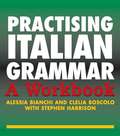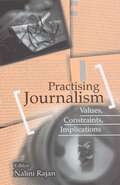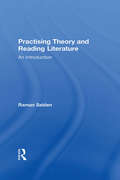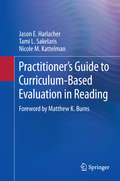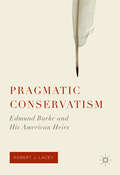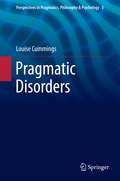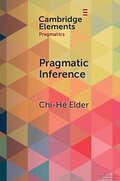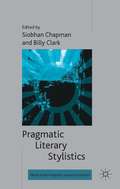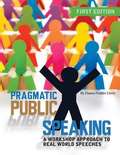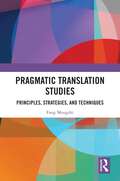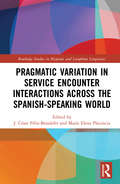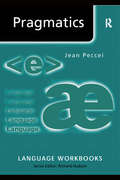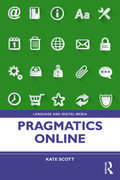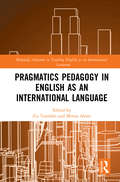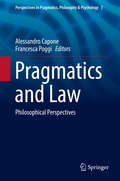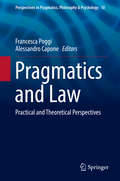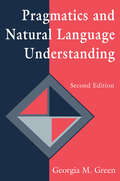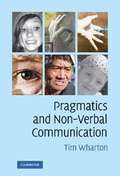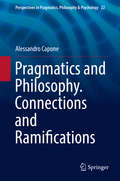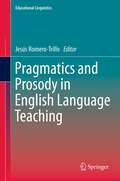- Table View
- List View
Practising Italian Grammar: A Workbook (Practising Grammar Workbooks)
by Stephen Harrison Alessia Bianchi Clelia BoscoloPractising Italian Grammar offers a comprehensive set of varied exercises for developing a greater practical awareness of the language. It is designed as a companion volume to A Reference Grammar of Modern Italian by Maiden and Robustelli, but it can also be used on its own by anyone wishing to improve their proficiency in Italian. The workbook includes examples of authentic Italian from journalistic and literary extracts, and from colloquial usage. The exercises are graded in terms of difficulty. Level 1 - revision of essential points, Level 2 - intermediate exercises, Level 3 - advanced exercises.A key to the exercises is provided making this workbook suitable for private study and classroom use.
Practising Journalism: Values, Constraints, Implications
by Nalini RajanPractising Journalism brings together experts from the field of journalism: journalists; freelance writers; lectures; and media practitioners to provide a comprehensive collection of current articles. Offering a unique view of the way journalism is both practiced and taught, this book is divided into four section: core values in journalism; specialisation within the craft; the constraints of practice and implications for the future. It covers areas including: gender and identity in the popular press; sports journalism; urban reporting; embedded journalism; censorship; and alternative media. This book is essential reading for students of journalism and all those considering a career in the field.
Practising Spanish Grammar
by Christopher Pountain Teresa De Carlos Angela HowkinsThis third edition of PRACTISING SPANISH GRAMMAR offers you a wide variety of exercises that put Spanish grammar into practice so you can understand better how the language is used today. Thoroughly updated, PRACTISING SPANISH GRAMMAR THIRD EDITION includes:a glossary that explains grammatical terms clearly, providing you with a useful reference guide to the tools of the languagelevel indicators with all exercises to help you progress at your own pace translations for key words within the exercises so you can work without having to stop and refer to a dictionaryanswers to all the exercises so you can use this book in class or at homea range of exercise types that cater for different learning strategies to help build your confidence in Spanish.With its broad variety of brand-new and revised exercises designed to stimulate and engage even the most grammar-shy students, this third edition can be used independently or as the ideal companion to the new fifth edition of the widely acclaimed A NEW REFERENCE GRAMMAR OF MODERN SPANISH FIFTH EDITION by John Butt and Carmen Benjamin.
Practising Spanish Grammar (Practising Grammar Workbooks)
by Christopher Pountain Teresa De Carlos Angela HowkinsPractising Spanish Grammar can be used independently or as the ideal companion to the sixth edition of the widely acclaimed A New Reference Grammar of Modern Spanish (Butt, Benjamin and Moreira Rodríguez). Thoroughly updated, this fourth edition of the workbook features an improved organization which closely mirrors that of A New Reference Grammar of Modern Spanish, sixth edition. The selection of exercises has been fully revised and expanded with new exercises on a variety of topics including possessives, conditional, future and past tenses, and polite requests. Designed to stimulate and engage even the most grammar-shy students, this is an ideal resource for Spanish learners at CEFR Level B2–C1, ACFTL Intermediate-High to Advanced.
Practising Theory and Reading Literature: An Introduction
by Raman SeldenPractising Theory and Reading Literature provides an accessible introduction to the study of contemporary literary theories and their applications to a range of literary texts. This is an elementary introduction where the emphasis is on practice, and in this respect it complements A Reader's Guide to Contemporary Literary Theory.
Practitioner's Guide to Curriculum-Based Evaluation in Reading
by Jason E. Harlacher Tami L. Sakelaris Nicole M. KattelmanThe educators are dedicated and concerned. The curriculum is successful. Yet some students aren't reading at grade level, and meetings air problems without making progress. Many students continue to flounder, leading to more meetings with the same lack of meaningful results. The Practitioner's Guide to Curriculum-Based Evaluation in Reading gives researchers and professionals the means to break this frustrating cycle, crafted by authors who have not only been there and done that, but can explain in depth how to replicate the method. Focusing on reading but applicable across subject areas, this highly accessible guide defines curriculum-based evaluation (CBE), provides conceptual background, and analyzes its component steps. Assessment and intervention are given equal attention within a problem-solving model featuring tools for skill assessment, progress monitoring, goal setting, and other bedrock tasks. Chapters build to lead readers beyond classroom strategies to guidelines for problem solving and decision making to effectively address individual student needs. Included in the coverage: The curriculum-based evaluation process. Relating CBE to the Multi-Tier System of Support model. Using CBE in daily practice, both in classwork and schoolwide. Decoding, early literacy, and reading comprehension. Progress monitoring and decision making. Plus FAQs, handouts, and other supplemental materials. This level of educational insight and pedagogical detail make the Practitioner's Guide to Curriculum-Based Evaluation in Reading a clarion call for researchers, graduate students, and professionals in school and clinical child psychology; assessment, testing, and evaluation; applied linguistics; language education; special education and allied education; educational psychology; and social work.
Pragmatic Conservatism
by Robert J. LaceyThis book is a study of pragmatic conservatism, an underappreciated tradition in modern American political thought, whose origins can be located in the ideas of Edmund Burke. Beginning with an exegesis of Burke's thought, it goes on to show how three twentieth-century thinkers who are not generally recognized as conservatives--Walter Lippmann, Reinhold Niebuhr, and Peter Viereck--carried on the Burkean tradition and adapted it to American democracy. Pragmatic conservatives posit that people, sinful by nature, require guidance from traditions that embody enduring truths wrought by past experience. Yet they also welcome incremental reform driven by established elites, judiciously departing from precedent when necessary. Mindful that truth is never absolute, they eschew ideology and caution against both bold political enterprises and stubborn apologies for the status quo. The book concludes by contrasting this more nuanced brand of conservatism with the radical version that emerged in the wake of the post-war Buckley revolution.
Pragmatic Disorders
by Louise CummingsThis wide-ranging survey of the state of the art in clinical pragmatics includes an examination of pragmatic disorders in previously neglected populations such as juvenile offenders, children and adults with emotional and behavioural disorders, and adults with non-Alzheimer dementias. This book makes a significant contribution to the discussion of pragmatic disorders by exploring topics which have a fast-rising profile in the field. These topics include disorders in which there are both pragmatic and cognitive components, and studies of the complex impacts of pragmatic disorders such as mental health problems, educational disadvantage and social exclusion. This book also presents a critical evaluation of our current state of knowledge of pragmatic disorders. The author focuses on the lack of integration between theoretical and clinical branches of pragmatics and argues that the work of clinicians is all too often inadequately informed by theoretical frameworks. She attempts to bridge these gaps by pursuing a closer alliance of clinical and theoretical branches of pragmatics. It is claimed that this alliance represents the most promising route for the future development of the field. At once a yardstick measuring progress thus far in clinical pragmatics, and also a roadmap for future research development, this single-author volume defines where we have reached in the field, as well as where we have to go next.
Pragmatic Inference: Misunderstandings, Accountability, Deniability (Elements in Pragmatics)
by Chi-Hé ElderThe concept of inference is foundational to the study of pragmatics; however, the way it is theoretically conceptualised and methodologically operationalised is far from uniform. This Element investigates the role that inference plays in pragmatic models of communication, bringing together a range of scholarship that characterises inference in different ways for different purposes. It addresses the nature of 'faulty inferences', promoting the study of misunderstandings as crucial for understanding inferential processes, and looking at sociopragmatic issues such as the role of commitment, accountability and deniability of inferences in interpersonal communication. This Element highlights that the question of where the locus of meaning lies is not only relevant to pragmatic theory but is also of paramount importance for understanding and managing real-life interpersonal communication conflict.
Pragmatic Literary Stylistics
by Billy Clark Siobhan ChapmanIn considering the ways in which current theories of language in use and communicative processes are applied to the analysis, interpretation and definition of literary texts, this book sets an agenda for the future of pragmatic literary stylistics and provides a foundation for future research and debate.
Pragmatic Markers in British English
by Kate BeechingFundamental to oral fluency, pragmatic markers facilitate the flow of spontaneous, interactional and social conversation. Variously termed 'hedges', 'fumbles' and 'conversational greasers' in earlier academic studies, this book explores the meaning, function and role of 'well', 'I mean', 'just', 'sort of', 'like' and 'you know' in British English. Adopting a sociolinguistic and historical perspective, Beeching investigates how these six commonly occurring pragmatic markers are used and the ways in which their current meanings and functions have evolved. Informed by empirical data from a wide range of contemporary and historical sources, including a small corpus of spoken English collected in 2011–14, the British National Corpus and the Old Bailey Corpus, Pragmatic Markers in British English contributes to debates about language variation and change, incrementation in adolescence and grammaticalisation and pragmaticalisation. It will be fascinating reading for researchers and students in linguistics and English, as well as non-specialists intrigued by this speech phenomenon.
Pragmatic Public Speaking: A Workshop Approach to Real World Speeches (first Edition)
by Danna Prather Davis""Pragmatic Public Speaking: A Workshop Approach to Real World Speeches" explains why speaking well is a necessary tool for professional success, and how to speak well in a variety of situations and genres. Using a workbook format, each chapter of the book discusses why a particular type of speech is useful and gives tips on preparation and provides two practice assignments. The initial chapters deal with speech preparation strategies such outlining and organizing informative speeches, researching, and creating visual aids. Then, students learn about the components of effective delivery-- voice and body language. the final chapters address the art of persuasive speaking, which includes understanding claims, fallacies, and advocacy. Every chapter includes a brainstorm box to help students prepare, a speech checklist for review, an atomistic evaluation, and a holistic evaluation. As they move through the book, readers learn how to analyze speeches, look for logical chains of progression, and identify flaws in logic. Designed to prepare students for a successful communication future, "Pragmatic Public Speaking" can be used in introductory communication and public speaking courses. Danna Prather Davis is an assistant professor of communication at Suffolk County Community College in Selden, New York. She completed her undergraduate studies at the University of Texas and her graduate coursework at the University of Alabama and the University of Iowa. She currently teaches courses in human communication, public speaking, and gender and communication. in addition, Professor Prather Davis is the advisor to the Student Veteran's Association, and the assistant forensics coach, and holds a leadership role with the National Communication Association. "
Pragmatic Translation Studies: Principles, Strategies, and Techniques
by Fang MengzhiThis book aims to strengthen the link between applied translation theory and practice by elucidating translation principles, strategies, and techniques within a unified theoretical framework.The author encapsulates the development of translation studies and its terminological system into a tripartite structure that unifies the study of translation through macro, meso, and micro approaches. The macro approach examines trends in translation studies, the meso approach focuses on translation strategies, and the micro approach explores the rationale and characteristics of translation skills. Meticulously structured and clear, this book offers both ideological guidance and methodological explication. It combines theoretical exposition with professional analysis, providing a profound and engaging perspective that bridges theory and practice.This title will serve as an invaluable reference for translation practitioners, researchers, and students of translation studies and interpreting theory and practice.
Pragmatic Variation in Service Encounter Interactions across the Spanish-Speaking World (Routledge Studies in Hispanic and Lusophone Linguistics)
by J. César Félix-Brasdefer Maria Elena PlacenciaPragmatic Variation in Service Encounter Interactions across the Spanish-Speaking World expands the study of service encounter interactions into new face-to-face and digital contexts and new (sub)varieties of Spanish. The chapters examine pragmatic variation in a range of contexts, representing ten countries and twelve (sub)varieties of Spanish. Part I explores macrosocial factors such as region, gender, age, and social class, while Part II focuses on microsocial and situational factors. Part III concludes the volume with theoretical and methodological contributions to the field. This volume will be of particular interest to advanced students and researchers of Spanish and Linguistics.
Pragmatic and Discourse Disorders
by Louise CummingsAn essential study aid for students of speech and language pathology, this highly practical workbook includes short-answer questions and data analysis exercises which help students to test and improve their knowledge of pragmatic and discourse disorders. The book contains a detailed examination of the causes, language and cognitive features of these disorders and includes frequently encountered clinical populations and conditions that are overlooked by other texts. The use of actual linguistic data provides readers with an authentic insight into the clinical setting. • 200 short-answer questions help students to develop and test their knowledge of pragmatic and discourse disorders • 67 data analysis exercises provide readers with real-life clinical scenarios • Fully worked answers are provided for all exercises, saving the lecturer time and allowing the reader to self-test and improve understanding • A detailed glossary of terms makes the text a self-contained reference tool • Carefully selected suggestions for further reading are provided for each chapter.
Pragmatics
by Stephen C. LevinsonThose aspects of language use that are crucial to an understanding of language as a system, and especially to an understanding of meaning, are the acknowledged concern of linguistic pragmatics. Yet until now much of the work in this field has not been easily accessible to the student, and was often written at an intimidating level of technicality. In this textbook, however, Dr Levinson has provided a lucid and integrative analysis of the central topics in pragmatics - deixis, implicature, presupposition, speech acts, and conversational structure. A central concern of the book is the relation between pragmatics and semantics, and Dr Levinson shows clearly how a pragmatic approach can resolve some of the problems semantics have been confronting and simplifying semantic analyses. The complexity of these issues is not disguised, but the exposition is always clear and supported by helpful exemplification. The detailed analyses of selected topics give the student a clear view of the empirical rigour demanded by the study of linguistic pragmatics, but Dr Levinson never loses sight of the rich diversity of the subject. An introduction and conclusion relate pragmatics to other fields in linguistics and other disciplines concerned with language usage - psychology, philosophy, anthropology and literature. Many students in these disciplines, as well as students of linguistics, will find this a valuable textbook.
Pragmatics (Language Workbooks)
by Jean Stilwell PecceiIn Pragmatics, the study of meaning derived from context, Jean Stilwell Peccei offers a practical introduction to this core area of linguistics. Pragmatics: encourages the reader to look at different levels of meaning within sentences provides a basic understanding of key pragmatic concepts introduces two highly influential approaches to pragmatics: the Co-Operative Principle and Speech Act Theory encourages the reader to apply basic analytical tools to real data, eg. advertising language and children's conversations provides a range of activities, discussion questions, an answer key and further reading.
Pragmatics Online (Language and Digital Media)
by Kate ScottPragmatics Online examines the use and interpretation of language and communication in digitally mediated contexts. It provides insight into how meaning is communicated online, with a focus on how users negotiate and navigate the constraints and resources of social media sites and other online contexts. The book introduces key concepts in the study of digital contexts and online communication, and discusses how these can be understood from the perspective of pragmatics. Each chapter examines a different topic and includes an overview of key research alongside original pragmatic analyses of data. Topics include sharing and liking, emoji and emotions, memes, and clickbait. Kate Scott focuses on how ideas and topics from pragmatics can be applied to mediated contexts, irrespective of the particular media. The book is an essential guide to the pragmatics of online discourse and behaviour for students and researchers working in the areas of digital pragmatics, language and media, and English language, linguistics, and communication studies.
Pragmatics Pedagogy in English as an International Language (Routledge Advances in Teaching English as an International Language Series)
by Zia Tajeddin and Minoo AlemiPragmatics Pedagogy in English as an International Language aims to bring to light L2 pragmatics instruction and assessment in relation to English as an International Language (EIL). The chapters in this book deal with a range of pedagogically related topics, including the historical interface between L2 pragmatics and EIL, reconceptualization of pragmatic competence in EIL, intercultural dimension of pragmatics pedagogy in EIL, teacher pragmatic awareness of instruction in the context of EIL, pragmatics of politeness in EIL, pragmatic teaching materials for EIL pedagogy, teachers’ and scholars’ perceptions of pragmatics pedagogy in EIL, assessment and assessment criteria in EIL-aware pragmatics, and methods for research into pragmatics in EIL. This book is different from other books about both EIL pedagogy and pragmatics pedagogy. Exploring the interface between different dimensions of pragmatics pedagogy and EIL, it suggests instructional and assessment tasks for EIL-aware pedagogy and directions for research on EIL-based pragmatics pedagogy. Pragmatics Pedagogy in English as an International Language will be useful for a range of readers who have an interest in the pragmatics instruction and assessment of EIL as well as those whose main area of specialization is EIL but would like to know how EIL, with its rich conceptual and empirical background, can go beyond linguistic instruction to embrace the instruction of pragmatic competence.
Pragmatics and Law
by Alessandro Capone Francesca PoggiThis volume highlights important aspects of the complex relationship between common language and legal practice. It hosts an interdisciplinary discussion between cognitive science, philosophy of language and philosophy of law, in which an international group of authors aims to promote, enrich and refine this new debate. Philosophers of law have always shown a keen interest in cognitive science and philosophy of language in order to find tools to solve their problems: recently this interest was reciprocated and scholars from cognitive science and philosophy of language now look to the law as a testing ground for their theses. Using the most sophisticated tools available to pragmatics, sociolinguistics, cognitive sciences and legal theory, an interdisciplinary, international group of authors address questions like: Does legal interpretation differ from ordinary understanding? Is the common pragmatic apparatus appropriate to legal practice? What can pragmatics teach about the concept of law and pervasive legal phenomena such as testimony or legal disagreements?
Pragmatics and Law
by Alessandro Capone Francesca PoggiThis volume is the second part of a project which hosts an interdisciplinary discussion about the relationship among law and language, legal practice and ordinary conversation, legal philosophy and the linguistics sciences. An international group of authors, from cognitive science, philosophy of language and philosophy of law question about how legal theory and pragmatics can enrich each other. In particular, the first part is devoted to the analysis of how pragmatics can solve problems related to legal theory: What can pragmatics teach about the concept of law and its relationship with moral, and, in particular, about the eternal dispute between legal positivism and legal naturalism? What can pragmatics teach about the concept of law and/or legal disagreements? The second part is focused on legal adjudication: it aims to construct a pragmatic apparatus appropriate to legal trial and/or to test the tenure of the traditional pragmatics tools in the field. The authors face questions such as: Which interesting pragmatic features emerge from legal adjudication? What pragmatic theories are better suited to account for the practice of judgment or its particular aspects (such as the testimony or the binding force of legal precedents)? Which pragmatic and socio-linguistic problems are highlighted by this practice?
Pragmatics and Natural Language Understanding (Tutorial Essays in Cognitive Science Series)
by Georgia M. GreenThis book differs from other introductions to pragmatics in approaching the problems of interpreting language use in terms of interpersonal modelling of beliefs and intentions. It is intended to make issues involved in language understanding, such as speech, text, and discourse, accessible to the widest group possible -- not just specialists in linguistics or communication theorists -- but all scholars and researchers whose enterprises depend on having a useful model of how communicative agents understand utterances and expect their own utterances to be understood. Based on feedback from readers over the past seven years, explanations in every chapter have been improved and updated in this thoroughly revised version of the original text published in 1989. The most extensive revisions concern the relevance of technical notions of mutual and normal belief, and the futility of using the notion 'null context' to describe meaning. In addition, the discussion of implicature now includes an extended explication of "Grice's Cooperative Principle" which attempts to put it in the context of his theory of meaning and rationality, and to preclude misinterpretations which it has suffered over the past 20 years. The revised chapter exploits the notion of normal belief to improve the account of conversational implicature.
Pragmatics and Non-Verbal Communication
by Tim WhartonThe way we say the words we say helps us convey our intended meanings. Indeed, the tone of voice we use, the facial expressions and bodily gestures we adopt while we are talking, often add entirely new layers of meaning to those words. How the natural non-verbal properties of utterances interact with linguistic ones is a question that is often largely ignored. This book redresses the balance, providing a unique examination of non-verbal behaviours from a pragmatic perspective. It charts a point of contact between pragmatics, linguistics, philosophy, cognitive science, ethology and psychology, and provides the analytical basis to answer some important questions: How are non-verbal behaviours interpreted? What do they convey? How can they be best accommodated within a theory of utterance interpretation?
Pragmatics and Philosophy. Connections and Ramifications (Perspectives in Pragmatics, Philosophy & Psychology #22)
by Alessandro CaponeThis book shows how pragmatics and philosophy are interconnected, and explores the consequences and ramifications of this innovative idea, especially in addressing and solving the problem of breaking Grice's circle. The author applies philosophy in order to get to a better understanding of pragmatics, and pragmatics in order to get a better understanding of philosophy. The book starts with a chapter on the non-cancellability of explicatures and the role that this idea plays in the resolution of Grice’s circle, and proceeds with the discussion of other topics in which explicatures or cancellability play an important and decisive role. While the reader proceeds in the reading of this book, they accumulate notions and pieces of knowledge which will be of invaluable use when arriving at the chapter on conversational presuppositions (and related chapters), where the author expresses his most radical views: namely that (potential) presuppositions are indeed cancellable, contrary to what many believe.
Pragmatics and Prosody in English Language Teaching
by Jesús Romero-TrilloThis volume explores the elusive subject of English prosody--the stress, rhythm and intonation of the language--, and its relevance for English language teaching. Its sharp focus will be especially welcomed by teachers of English to non-native speakers, but also by scholars and researchers interested in Applied Linguistics. The book examines key issues in the development of prosody and delves into the role of intonation in the construction of meaning. The contributions tackle difficult areas of intonation for language learners, providing a theoretical analysis of each stumbling block as well as a practical explanation for teachers and teacher trainers. The numerous issues dealt with in the book include stress and rhythm; tone units and information structure; intonation and pragmatic meaning; tonicity and markedness, etc... The authors have deployed speech analysis software to illustrate their examples as well as to encourage readers to carry out their own computerized prosodic analyses.
